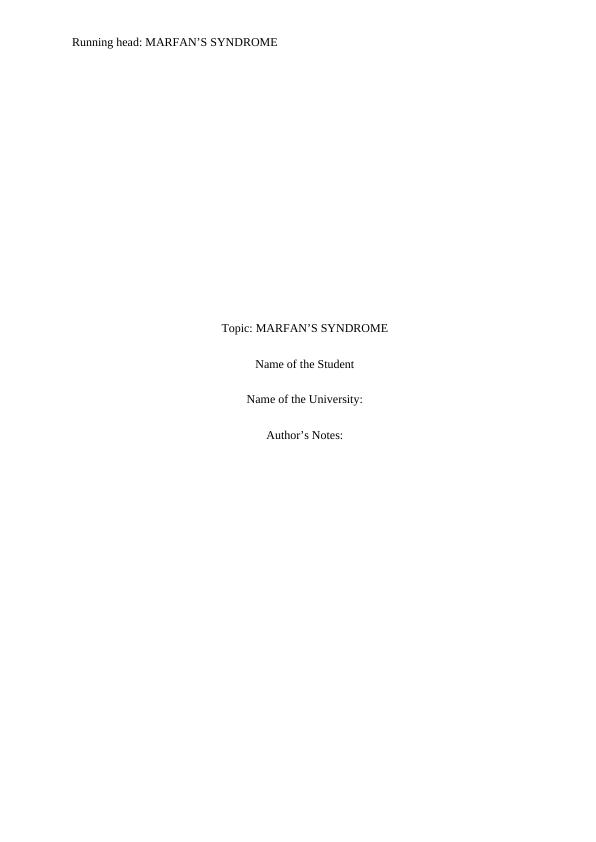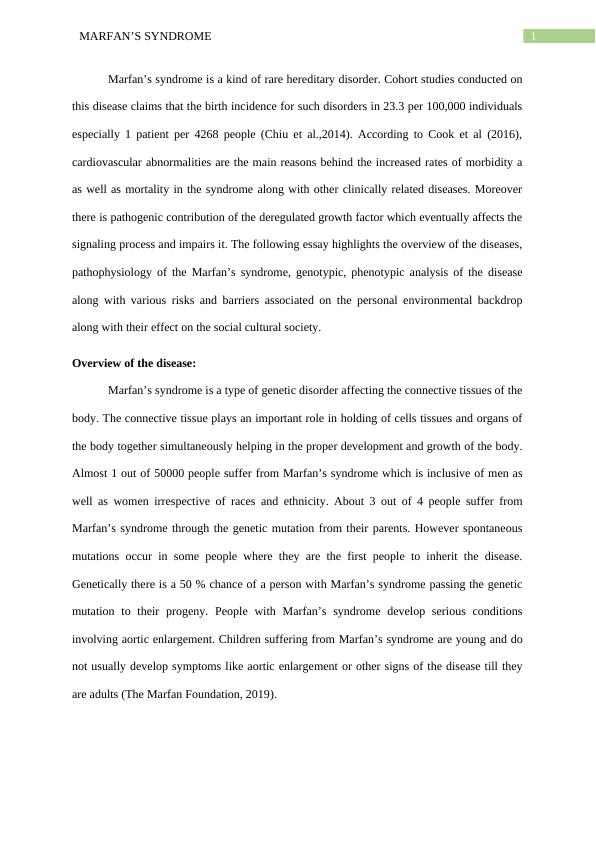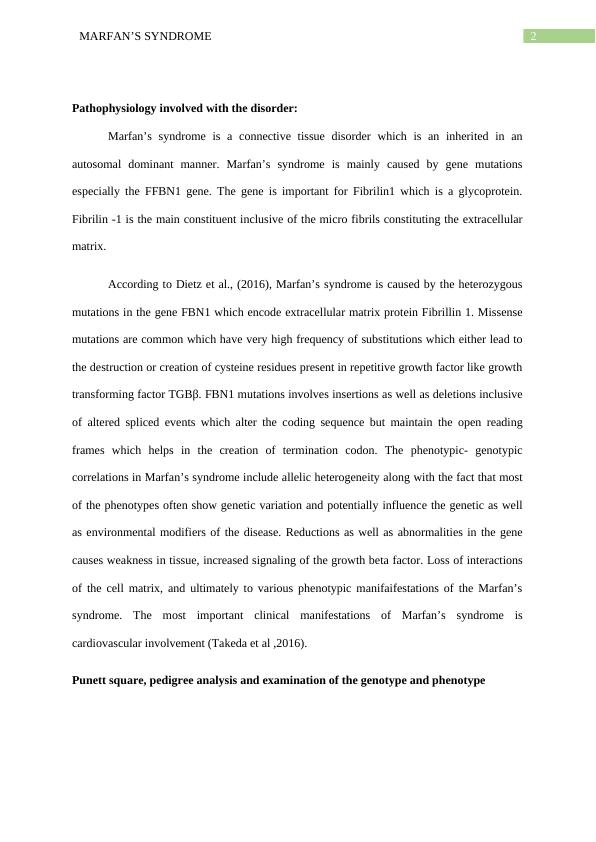Marfan's Syndrome: Overview, Pathophysiology, and Genetic Testing
Added on 2023-04-21
13 Pages3579 Words473 Views
Running head: MARFAN’S SYNDROME
Topic: MARFAN’S SYNDROME
Name of the Student
Name of the University:
Author’s Notes:
Topic: MARFAN’S SYNDROME
Name of the Student
Name of the University:
Author’s Notes:

1MARFAN’S SYNDROME
Marfan’s syndrome is a kind of rare hereditary disorder. Cohort studies conducted on
this disease claims that the birth incidence for such disorders in 23.3 per 100,000 individuals
especially 1 patient per 4268 people (Chiu et al.,2014). According to Cook et al (2016),
cardiovascular abnormalities are the main reasons behind the increased rates of morbidity a
as well as mortality in the syndrome along with other clinically related diseases. Moreover
there is pathogenic contribution of the deregulated growth factor which eventually affects the
signaling process and impairs it. The following essay highlights the overview of the diseases,
pathophysiology of the Marfan’s syndrome, genotypic, phenotypic analysis of the disease
along with various risks and barriers associated on the personal environmental backdrop
along with their effect on the social cultural society.
Overview of the disease:
Marfan’s syndrome is a type of genetic disorder affecting the connective tissues of the
body. The connective tissue plays an important role in holding of cells tissues and organs of
the body together simultaneously helping in the proper development and growth of the body.
Almost 1 out of 50000 people suffer from Marfan’s syndrome which is inclusive of men as
well as women irrespective of races and ethnicity. About 3 out of 4 people suffer from
Marfan’s syndrome through the genetic mutation from their parents. However spontaneous
mutations occur in some people where they are the first people to inherit the disease.
Genetically there is a 50 % chance of a person with Marfan’s syndrome passing the genetic
mutation to their progeny. People with Marfan’s syndrome develop serious conditions
involving aortic enlargement. Children suffering from Marfan’s syndrome are young and do
not usually develop symptoms like aortic enlargement or other signs of the disease till they
are adults (The Marfan Foundation, 2019).
Marfan’s syndrome is a kind of rare hereditary disorder. Cohort studies conducted on
this disease claims that the birth incidence for such disorders in 23.3 per 100,000 individuals
especially 1 patient per 4268 people (Chiu et al.,2014). According to Cook et al (2016),
cardiovascular abnormalities are the main reasons behind the increased rates of morbidity a
as well as mortality in the syndrome along with other clinically related diseases. Moreover
there is pathogenic contribution of the deregulated growth factor which eventually affects the
signaling process and impairs it. The following essay highlights the overview of the diseases,
pathophysiology of the Marfan’s syndrome, genotypic, phenotypic analysis of the disease
along with various risks and barriers associated on the personal environmental backdrop
along with their effect on the social cultural society.
Overview of the disease:
Marfan’s syndrome is a type of genetic disorder affecting the connective tissues of the
body. The connective tissue plays an important role in holding of cells tissues and organs of
the body together simultaneously helping in the proper development and growth of the body.
Almost 1 out of 50000 people suffer from Marfan’s syndrome which is inclusive of men as
well as women irrespective of races and ethnicity. About 3 out of 4 people suffer from
Marfan’s syndrome through the genetic mutation from their parents. However spontaneous
mutations occur in some people where they are the first people to inherit the disease.
Genetically there is a 50 % chance of a person with Marfan’s syndrome passing the genetic
mutation to their progeny. People with Marfan’s syndrome develop serious conditions
involving aortic enlargement. Children suffering from Marfan’s syndrome are young and do
not usually develop symptoms like aortic enlargement or other signs of the disease till they
are adults (The Marfan Foundation, 2019).

2MARFAN’S SYNDROME
Pathophysiology involved with the disorder:
Marfan’s syndrome is a connective tissue disorder which is an inherited in an
autosomal dominant manner. Marfan’s syndrome is mainly caused by gene mutations
especially the FFBN1 gene. The gene is important for Fibrilin1 which is a glycoprotein.
Fibrilin -1 is the main constituent inclusive of the micro fibrils constituting the extracellular
matrix.
According to Dietz et al., (2016), Marfan’s syndrome is caused by the heterozygous
mutations in the gene FBN1 which encode extracellular matrix protein Fibrillin 1. Missense
mutations are common which have very high frequency of substitutions which either lead to
the destruction or creation of cysteine residues present in repetitive growth factor like growth
transforming factor TGBβ. FBN1 mutations involves insertions as well as deletions inclusive
of altered spliced events which alter the coding sequence but maintain the open reading
frames which helps in the creation of termination codon. The phenotypic- genotypic
correlations in Marfan’s syndrome include allelic heterogeneity along with the fact that most
of the phenotypes often show genetic variation and potentially influence the genetic as well
as environmental modifiers of the disease. Reductions as well as abnormalities in the gene
causes weakness in tissue, increased signaling of the growth beta factor. Loss of interactions
of the cell matrix, and ultimately to various phenotypic manifaifestations of the Marfan’s
syndrome. The most important clinical manifestations of Marfan’s syndrome is
cardiovascular involvement (Takeda et al ,2016).
Punett square, pedigree analysis and examination of the genotype and phenotype
Pathophysiology involved with the disorder:
Marfan’s syndrome is a connective tissue disorder which is an inherited in an
autosomal dominant manner. Marfan’s syndrome is mainly caused by gene mutations
especially the FFBN1 gene. The gene is important for Fibrilin1 which is a glycoprotein.
Fibrilin -1 is the main constituent inclusive of the micro fibrils constituting the extracellular
matrix.
According to Dietz et al., (2016), Marfan’s syndrome is caused by the heterozygous
mutations in the gene FBN1 which encode extracellular matrix protein Fibrillin 1. Missense
mutations are common which have very high frequency of substitutions which either lead to
the destruction or creation of cysteine residues present in repetitive growth factor like growth
transforming factor TGBβ. FBN1 mutations involves insertions as well as deletions inclusive
of altered spliced events which alter the coding sequence but maintain the open reading
frames which helps in the creation of termination codon. The phenotypic- genotypic
correlations in Marfan’s syndrome include allelic heterogeneity along with the fact that most
of the phenotypes often show genetic variation and potentially influence the genetic as well
as environmental modifiers of the disease. Reductions as well as abnormalities in the gene
causes weakness in tissue, increased signaling of the growth beta factor. Loss of interactions
of the cell matrix, and ultimately to various phenotypic manifaifestations of the Marfan’s
syndrome. The most important clinical manifestations of Marfan’s syndrome is
cardiovascular involvement (Takeda et al ,2016).
Punett square, pedigree analysis and examination of the genotype and phenotype

3MARFAN’S SYNDROME
M m
Punette squares are useful in determination of genotypes through proper crossing or
breeding experiments. From the evaluation of the Punett Square for Marfan’s syndrome, the
genotypes of the parents have been considered with the alleles M and m. The combination of
the alleles have been represented through Punette Square and it can be seen that almost 50 %
of chances of disease transmission is there. Among the possible genotypes of the off-springs,
one of them is a carrier and the other is not a carrier. Overall the result of getting the disease
from the parents is 50-50.
m
m
?
Mm mm
Mm Mm
M m
Punette squares are useful in determination of genotypes through proper crossing or
breeding experiments. From the evaluation of the Punett Square for Marfan’s syndrome, the
genotypes of the parents have been considered with the alleles M and m. The combination of
the alleles have been represented through Punette Square and it can be seen that almost 50 %
of chances of disease transmission is there. Among the possible genotypes of the off-springs,
one of them is a carrier and the other is not a carrier. Overall the result of getting the disease
from the parents is 50-50.
m
m
?
Mm mm
Mm Mm

End of preview
Want to access all the pages? Upload your documents or become a member.
Related Documents
Down Syndrome: Symptoms, Prognosis, Inheritance Patterns, Treatment Intervention, and Preventionlg...
|8
|2440
|280
Medical Genetics and Genomicslg...
|9
|1490
|20
Thalassemia: An Inherited Blood Disorder - Overview, Inheritance Pattern, Types, Clinical Presentation, Treatment, Genetic Counselling, Pedigree Analysislg...
|10
|744
|194
Genetic Disorders: Chromosomal Mutation vs Gene Mutation and Case Studieslg...
|9
|2462
|145
Pathophysiology Australia Report 2022lg...
|4
|994
|20
Schizophrenia and Atypical Antipsychotics | Reportlg...
|12
|2842
|22
